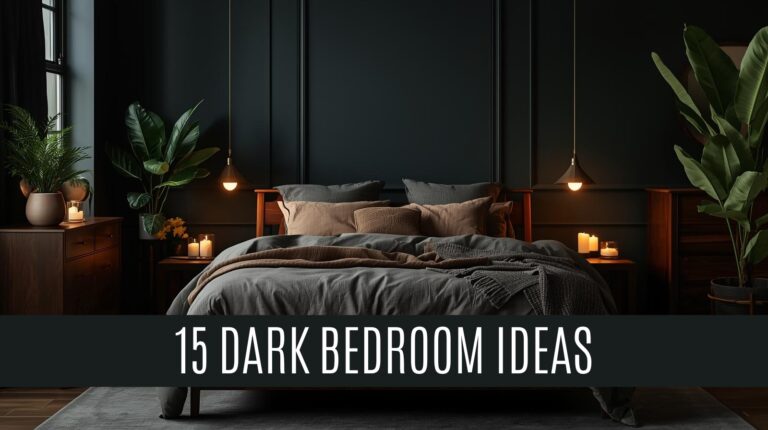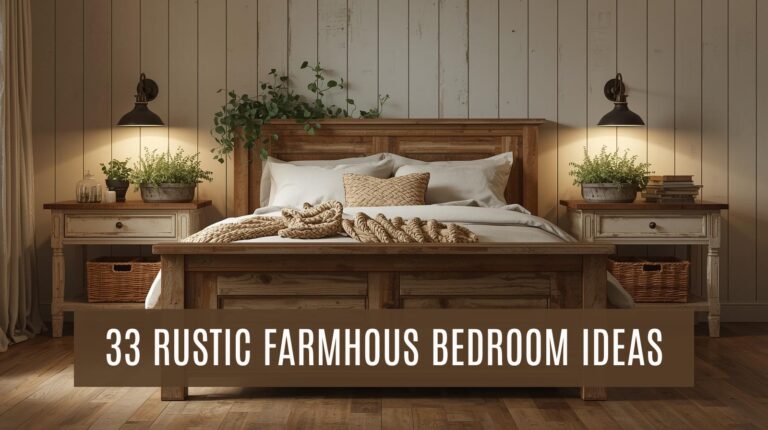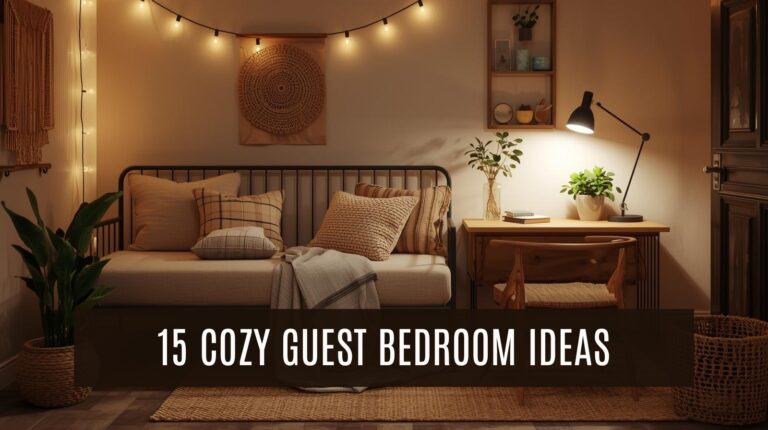25 Small Bedroom Ideas That Feel Cozy, Not Cramped
Small bedrooms can feel tricky to get right. One wrong piece of furniture or too many little things on the dresser and suddenly the space feels more cramped than cozy. But the good news is you don’t need more square footage to make your room feel calm and inviting. A few thoughtful choices can completely change how it feels.
The secret is to focus on comfort, not clutter. Think natural light, soft textures, warm lighting, and furniture that actually fits your space instead of fighting it. With the right setup, even the tiniest bedrooms can turn into a peaceful retreat at the end of the day.
The ideas ahead are simple, renter-friendly, and easy to try whether you’re in a studio apartment or a small home. So grab a cup of tea, take a look around your space, and get ready to make your bedroom feel cozy, not cramped.

1. Use Light, Airy Colors
Light colors make a small room feel open and breathable. Whites, soft grays, and muted pastels bounce light around and create a calm backdrop for your furniture and decor. Even if your walls are already neutral, you can layer in lighter bedding and curtains to keep the space feeling fresh.
If you love darker shades, use them in small touches. A navy throw pillow or a forest green vase adds depth without closing in the room. The trick is to keep the balance leaning toward light.
2. Add Texture Instead of Clutter
When space is tight, texture does the heavy lifting that too many decor items can’t. A chunky knit blanket, woven basket, or linen pillow cover brings warmth without crowding the room. These pieces add personality and coziness while keeping surfaces clear.
Try mixing materials like wood, cotton, and rattan for a natural, lived-in feel. Texture draws the eye and keeps things interesting, even if your color palette is simple.
3. Choose Multi-Functional Furniture
In a small bedroom, every piece should earn its place. A bed with drawers underneath or a nightstand that doubles as a desk can make a big difference in how the space feels. Look for furniture that helps with storage or serves more than one purpose.
This doesn’t mean everything has to be hidden away. A simple bench at the end of the bed can hold extra blankets or become a place to sit while getting dressed. It’s about finding balance between function and comfort.
4. Go Vertical with Shelving
When floor space is limited, the walls are your best friend. Floating shelves, wall hooks, and tall bookcases draw the eye upward and make the room feel taller. You’ll also free up more room for essentials without adding clutter to surfaces.
Keep shelves styled lightly with books, a small plant, or a few personal items. The goal is to make the most of your walls without overwhelming them.
5. Keep the Floor Clear
A cluttered floor makes any room feel smaller. Try to keep shoes, cords, and bags out of sight so the space feels open and calm. Even small changes, like sliding storage boxes under the bed or hanging a few hooks by the door, can make a big difference.
Think of the floor as breathing room for your space. The more visible it is, the larger your bedroom will feel.
6. Use Mirrors to Reflect Light
Mirrors are one of the easiest ways to make a small bedroom feel brighter and bigger. Place one opposite a window to bounce natural light around or behind a lamp to double the glow.
You don’t need a massive wall mirror to get the effect. A round mirror above the dresser or a full-length mirror on the back of the door adds both function and style.
7. Layer Soft Lighting
Harsh overhead lighting can make a small room feel flat and cold. Try using a few different light sources instead, like a bedside lamp, string lights, or a soft wall sconce. Layered lighting creates depth and warmth that instantly makes the space feel cozier.
Warm bulbs are your friend here. Aim for a soft glow rather than bright white light to help your room feel calm and inviting.
8. Try a Low Bed Frame
A lower bed frame helps open up vertical space, especially in small rooms with lower ceilings. It gives the illusion of more height while keeping things grounded and cozy. Platform beds or floor-style frames can work beautifully for this.
Pair your low bed with slim nightstands or simple wall shelves to keep proportions balanced. The result feels minimal but comfortable, not cramped.
9. Create a Cozy Nook
Even the smallest bedrooms can have a corner that feels special. Turn an unused space near a window or beside your bed into a reading nook or a quiet spot to unwind. A small chair, soft throw, and warm lighting can transform an empty corner into your favorite part of the room.
If you don’t have space for a chair, a pile of floor cushions or a narrow bench works just as well. The goal is to make a little area that feels like a personal retreat.
10. Simplify Your Bedding
Layers of pillows and heavy blankets might look nice online, but in a small bedroom they can make the bed feel bulky. Stick with a few soft layers you actually use, like a light duvet, one or two pillows, and a cozy throw.
Neutral or tone-on-tone bedding helps the room feel calm and uncluttered. Choose materials that feel good to the touch, and your bed will always invite you to slow down.
11. Add Plants for Freshness
A little greenery goes a long way in a small bedroom. Plants bring life, color, and a sense of calm to even the tiniest spaces. Choose easy-care varieties like pothos, snake plants, or peace lilies that can handle low light and don’t need constant attention.
You don’t need a jungle to get the effect. One or two small plants on a shelf or nightstand are enough to freshen the air and soften the room’s edges.
12. Use Storage Baskets That Match Your Decor
Storage doesn’t have to look boring or out of place. Woven baskets, canvas bins, or fabric boxes can hold everything from blankets to books while blending in with your decor. Matching the color or texture of your baskets to your room’s palette helps everything feel cohesive.
This is one of the easiest ways to stay organized without feeling like you’re constantly tidying up. When everything has a spot, your small bedroom feels calmer instantly.
13. Add a Statement Wall (Without Overpowering)
A small bedroom can still have personality. A single accent wall in a soft pattern or muted tone draws the eye without making the space feel busy. Wallpaper, peel-and-stick decals, or even a painted half wall can add just enough interest.
Keep the rest of the room simple so your statement wall stands out. When done right, it becomes a cozy focal point instead of visual clutter.
14. Opt for Curtains That Match the Wall Color
Curtains in a similar shade to your walls help the room feel taller and more seamless. The color flow tricks the eye into seeing one continuous line, which makes the space feel bigger.
Light, airy fabrics like cotton or linen are perfect for this. They soften the light and bring a gentle texture to the room without adding heaviness.
15. Hang Hooks for Everyday Items
Hooks are a lifesaver in small bedrooms. Use them to hang bags, robes, or hats instead of letting things pile up on furniture. They’re easy to install, take up almost no space, and keep your essentials within reach.
Choose hooks that fit your style—wood, metal, or even adhesive options for renters. A simple row by the door or behind it can make the room feel instantly tidier.
16. Choose a Few Large Decor Pieces
Instead of crowding shelves with lots of little things, go for a few larger decor pieces that make an impact. A single framed print, a ceramic vase, or a textured lamp adds personality without cluttering the space.
Larger pieces also make the room feel more intentional and balanced. It’s a small trick that keeps your space calm and easy on the eyes.
17. Create Zones with Rugs or Lighting
Even a small bedroom can feel more organized when you define little zones. A soft rug under the bed separates your sleeping area, while a lamp in a corner can mark a reading spot or workspace. These small visual cues make the room feel more intentional and less crowded.
Stick with rugs and lighting that share similar tones or materials to keep things cohesive. When everything flows together, the space feels calm and complete.
18. Use a Fold-Down Desk or Vanity
If you need a workspace or a spot for getting ready, a fold-down desk or wall-mounted shelf is a smart way to save space. You can fold it away when not in use, freeing up valuable floor area.
Pair it with a lightweight stool that can tuck underneath or double as a bedside table. Flexible pieces like these make small bedrooms work harder without feeling cramped.
19. Keep a Limited Color Palette
Too many colors can make a small space feel busy. Stick to two or three main tones and use them consistently across your bedding, decor, and walls. This creates flow and helps the room feel pulled together instead of patchy.
Neutrals are always a safe choice, but don’t be afraid to add a soft accent color. A few touches of blush, sage, or navy can bring personality without overwhelming the space.
20. Add Artwork That Expands the Space
Artwork can do more than decorate—it can change how a room feels. Choose pieces with light backgrounds, open landscapes, or subtle movement to give the illusion of depth. Avoid overly dark or crowded art that might make walls feel closer.
One or two framed prints are enough to add character. Hang them slightly higher than eye level to draw attention upward and create the sense of taller walls.
21. Make Your Bed the Focal Point
In a small bedroom, the bed naturally draws attention—so make it count. Choose bedding that feels inviting and fits the mood you want for the space. A simple headboard, neat layers, and soft textures can instantly make the room look more polished.
Keep nightstands and decor around the bed minimal so the area doesn’t feel crowded. When the bed looks cozy and cared for, the whole room feels more put together.
22. Use Floating Nightstands
Traditional nightstands can eat up precious floor space. Floating nightstands or small wall shelves give you a place to set your essentials without making the room feel heavy. They also make cleaning easier and leave more room to breathe.
Keep what you place on them simple—a lamp, a book, maybe a plant. Less really is more when it comes to making a small space feel calm.
23. Try Under-Bed Storage
The space under your bed is prime real estate in a small room. Use low bins, rolling drawers, or zip-up fabric bags to store off-season clothes, extra bedding, or shoes. Keeping these items tucked away frees up closet space and reduces visual clutter.
Choose storage that matches your bedding or floor color so it blends in seamlessly. The goal is to make storage part of the design, not an afterthought.
24. Add Personal Touches (But Keep It Minimal)
Your bedroom should still feel like yours, even if it’s small. Add a few meaningful items like a framed photo, a favorite candle, or a small piece of art that makes you happy. The key is to choose things that bring comfort rather than crowding the room.
Think about quality over quantity. A few personal details can make a space feel warm and lived-in without tipping into clutter.
25. Keep It Tidy with a Daily Reset
A small bedroom can go from peaceful to chaotic in a day. Take a few minutes each evening to put things back where they belong—fold a blanket, clear the nightstand, or hang up clothes instead of leaving them on a chair. It’s a simple habit that makes a big difference.
Keeping up with small tidying tasks helps the room stay calm and welcoming. When your space feels cared for, it’s easier to unwind and actually enjoy being there.
Small Bedroom, Big Comfort
You don’t need a big bedroom to feel comfortable. With a few intentional choices, even the smallest space can become a calm, inviting place to rest. Start with one or two ideas that feel doable right now, like swapping out heavy bedding, clearing your nightstand, or adding a plant.
Remember that cozy doesn’t mean crowded. It’s about creating a space that feels good to walk into at the end of the day. Keep it simple, keep it personal, and your small bedroom will feel anything but cramped.






